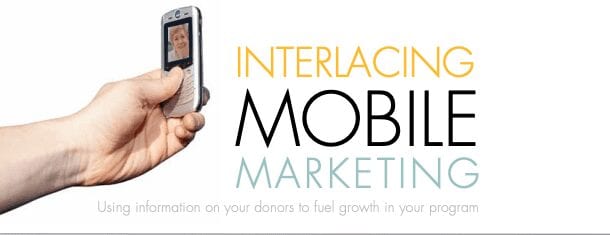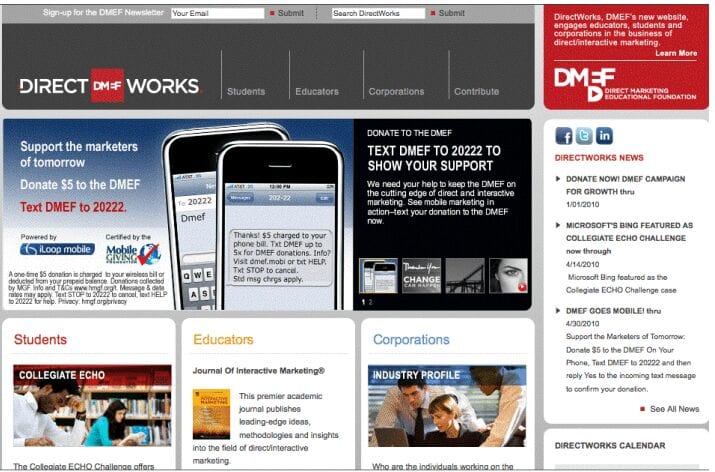This article was original published by the Journal of the DMA Nonprofit Federation. Volume 13: Issue 1 | January 2010

Just look around you, nearly everyone around you carries with them one or more wireless-enabled mobile devices. These devices come in all shapes and sizes and support a wide range of capabilities. The mobile device is so much more than a simple tool to place calls; increasingly mobile devices are being used to power and empower a wide range of services, engagements and conversations:
- Text messaging – over 4.1 billion text messages are sent each day in the U.S.
- Finding our way – Google is now offering navigation from the Android smartphone for free – lookout GPS devices.
- Engaging in social media – mobile is at parity, Facebook users spend 24 minutes a day on the site on average compared with 27.5 minutes by computer users, a 2009 British study found.
- Watching videos – roughly 7% of mobile subscribers watch video on their mobile phone, 41% if they’re on an iPhone.
- Listening to music – roughly 7% of mobile subscribers listen to full-length music on their mobile phone, 38% if they’re on an iPhone.
- Engaging in commerce (e.g. banking, pay a bill, transfer money) – PayPal reported a 140% spike in the volume of payments made by mobile phone on Black Friday in 2009 versus 2008.
- Receiving and redeeming coupons – Money Mailer reports 8~14% average response rates to permission-based text messaging alerts sent by its franchises.
- Participating in sweepstakes – by all accounts, sweepstakes are consistently one of the top three triggers that stimulate consumer participation in mobile marketing.
- Donating to charity – giving via mobile phones is in increasing, the industry saw a 471% increase in mobile giving in 2009 over 2008.
This is just the tip of the iceberg, use, use patterns and use cases are growing daily. In fact, for many, according to Nielsen, text messaging not voice has become the primary mobile communication channel of choice in the United States. Moreover, with mobile we’re not just talking about mobile phones. According to Mary Meeker of Morgan Stanley there are over 10 billion wireless-enabled devices in active use around the world today (for phones alone there 221 mobile subscribers in the U.S., many with multiple mobile devices). There are traditional featured phones, smartphones (i.e. Apple iPhone, Blackberry, Google Android, Windows Mobile Devices, etc.), netbooks, eBooks, entertainment terminals, navigation devices as so much more. As evident from the list above, the latest generation of mobile phones and devices have grown beyond their simple voice roots and can now be considered truly rich multi-modal communication and data platforms, platforms that support numerous channels of interactive engagement; such as, text messaging, multimedia messaging, email, content (like TV and radio), mobile Internet, Bluetooth and the ever increasingly application channel as popularized by the iPhone (there are now over 100K applications in the iPhone App store and over 2 billion applications have been downloaded since its launch two years ago— keep in mind the iPhone accounts for only roughly 3% of the mobile subscriber base in the U.S., the Apple iTouch—i.e. not a mobile phone--is actually a bigger driver of downloads over the iPhone). Now that the mobile phone and its cousins (the other wireless enabled devices) are so universally diffused and adopted in the market, marketers and consumers alike are embracing the practice of using them within ever more engaging ways. One of these ways is a practice often referred to as mobile marketing. The Mobile Marketing Association (www.mmaglobal.com) recently, November 2009, released an updated definition of mobile marketing:
Mobile Marketing is a set of practices that enables organizations to communicate and engage with their audience in an interactive and relevant manner through any mobile device or network. The key to this definition is to understand its key constructs.
- Practices: activities, institutions, processes, industry players, standards, advertising & media, direct response, promotions, relationship management, CRM, customer services, loyalty, social marketing, and all the many faces and facets of marketing.
- Organizations: Commercial entities, brands, agencies, marketers, nonprofits, enterprises, individuals, etc., with products, services, and offerings they wish to deliver to the market.
- • Communicate: Two-way communication, relationship management, deliver an advertisement or message, receive messages from one’s audience member, and enable communication among the members of one audience.
- Engage: Start relationships, acquire, generate activity, stimulate social interaction with an organization and community members, be present at the time of consumers expressed need, engagement can be initiated by the consumer (“Pull” in form of a click or response) and by the marketer (“Push”). Recognizes the co-value creation of commerce today, i.e. mutual value exchange, between organizations and consumers, the need for both parties to obtain value from any and all interactions.
- Relevant: all the factors that are pertinent to tailoring and personalizing the experience both for the organization and the consumer, including time, location, content, context and behavior
- Mobile device or Network: any wireless-enabled device regardless of form factor or network.
While there is much to understand when considering mobile marketing, the most critical piece to realize is that the mobile device is an incredibly personal medium. To this end marketers must obtain permission before initiating communication with an individual on his or her mobile device; such as, sending an individual a text message. The best way to go about obtaining an individual’s permission or generating awareness of your mobile-enhanced program, product and services is to integrate mobile marketing practices into all of your existing traditional and new media marketing activities (e.g. TV, print, radio, direct mail, email, Internet, outdoor media, etc.). In other words, to really take advantage of mobile marketing do not view the practice as a separate and independent activity to what you’re doing, but view it as an element that is brought into and integrated with all of your current and future marketing activities, including advertising and promotion, relationship management, transactions, social media and customer care.
There is so much that can be accomplished with the practice of mobile marketing that we simply can not touch upon all the of the capability within this article, however, there is one practice in particular that many nonprofits are taking note of that is touched on here; that is, the practice of mobile giving.
Mobile profits other sectors too
Mobile is no longer simply used in the domain of consumer packaging goods, retail and entertainment, as is often thought. Nonprofits are using the mobile channel and its many paths to share their organizational message, stimulate volunteerism and community, as well as to raise money through a new mobile practice commonly referred to as mobile giving. With mobile giving, nonprofits can invite people to donate to their organization by simply asking them to text message a keyword to a common short code and donate $5 or $10. Mobile giving was launched in the United States in 2008 by the Mobile Giving Foundation (www. mobilegiving.org) and in its first year helped raise $350,000 in donations and by the end of this year, 2009, according to the Jim Manis, CEO of the Mobile Giving Foundation (as reported by Mobile Marketer), donations and pledges accrued through mobile giving shall exceed $2 million, and this is just in the United States. In November 2009 the Mobile Giving Foundation announced support for mobile giving in Canada and it is expected that support in other countries will rollout over time.
Today, the process of mobile giving billing happens through a processes referred to as premium SMS (PSMS), i.e. via text messages flagged for billing, with the donation appearing on the mobile subscriber’s mobile phone bill or deducted from their mobile pre-paid account. For example, the Special Olympics Northern California (http://www. sonc.org) launched their mobile giving program earlier this year in order to help raise money to support its athletes. People interested in donating to the organization can text SONC (the keyword) to the 20222 (the Common Short Code) to donate $5 to the Northern California Special Olympics. Similarly, the Direct Marketing Educational Foundation (http://www.directworks.org) invites people to text DMEF to 20222 and donate $5 to support their efforts in educating students in the maturing practice of direct marketing. For more details on the terms and conditions of mobile giving programs, see http://mobilegiving.org/T/Default. aspx or the respective Web sites of either of these organizations.
Steps to mobile giving
As illustrated above, the consumer engagement process for mobile giving is straightforward. Here are the steps.
- Consumers see a call-to-action to donate in a traditional or new media channel and respond by text messaging or they can enter their mobile phone number into a form field on a wired Web or mobile Web site, by clicking a prompt in an interactive voice response audio call, shaking their mobile giving iPhone application or a similar Web services application. This is step is referred to as the “opt-in.”
- The opt-in triggers the application service provider and/or Mobile Giving Foundation’s servers to send a confirmation text message request to the mobile subscriber initiating the donation process, asking them to confirm their donation. the mobile device is an incredibly personal medium 26 27 3. The mobile subscriber then replies ‘Yes’ to the message to confirm the donation.
- Once the Mobile Giving Foundation receives the confirmation response, its servers process the billing and send a confirmation receipt via text to the mobile subscriber informing him or her that his or her phone bill has been charged and that he or she can donate up to a total of five times, not to exceed $25 dollars, in a month. It is at this last step that the billing happens. The mobile subscribers will not be charged until the confirmation is delivered.
It is worthy to note that mobile subscribers can always go the Mobile Giving Foundation Web site (http:// mobilegiving.org/SMS_Donations/ Default.aspx) to get a report of all the donations they have made. Also, it is important to note that the mobile giving engagement and messaging process are fixed and strictly controlled to ensure compliance with carrier and industry regulations.
Mobile giving players
Mobile giving in the United States and Canada is powered by the Mobile Giving Foundation (http://www. mobilegiving.org), its partners and customers, including:
- Wireless carriers: AT&T Wireless, Verizon Wireless, T-Mobile, Sprint Nextel
and U.S. Cellular - Mobile Giving Foundation certified application service providers: iLoop Mobile (
http :// www.iloopmobile.com), mPower (http://www.mpowergiving. com), Mobile Accord (http :// www.mobileaccord.com), MobileCause (http://www. mobilecause.com), Mobile Commons (http://www.mcommons. com), Wireless Factory (http :// www.wirelessfactory.com), Distributive Networks (http :// www.distributivenetworks.com), g8wave Inc (http://www.g8wave. com ), Give on (http://www. giveonthego.com) and Guide by Cell (http://www.givebycell.com) - Nonprofit organizations such as the Northern California Special Olympics (http://www. sonc.org), Direct Marketing Education Foundation (
http :// www.directworks.org), Keep a Child Alive (http://www. keepachildalive.org) and others (see http://www.mobilegiving.org/ charities.aspx for a partial list of the many nonprofit charities benefiting from mobile giving) The role of each player The entire mobile giving process hinges around the Mobile Giving Foundation and its relationship with each of the three organization classes above, the players. The following describes the role of each player, including the nonprofit organization. - The nonprofit organization is the charity or foundation which seeks to collect donations and engage the target audience through and with the mobile channel.
- The Mobile Giving Foundation is the founder of mobile giving and the mediator that coordinates mobile giving. Simply put, the Mobile Giving Foundation 1) coordinates the development and maintenance of the business and technical standards for mobile giving, 2) oversees the money flow between the donor, wireless carrier, itself and the nonprofit organization, and 3) manages its network of application service providers and other partners.
- Wireless carriers maintain the mobile networks, the billing process and all the network mechanics for making mobile giving a reality.
- Application service providers: Mobile Giving Foundation certified applications service providers and agencies play a number of roles, including 1) acting as the primary point of contact for the nonprofit organization and overseeing all the processes for getting the nonprofit organization’s programs approved and up and running, as well as 2) providing the nonprofit organization with any additional mobile channel and marketing services that the nonprofit would like to offer to engage its audience above and beyond the donation call-to-action, including text alerts, mobile Internet Sites and the mobile enhancement of the nonprofit’s traditional new media programs. And 3) often, the application service provider or agency, along with the nonprofit’s marketing team and agencies, will also provide mobile strategy and creative assistance as needed. The Mobile Giving Foundation hand selects and certifies its application service and agency provider partners.
Easy steps for a nonprofit to get involved
It is very straightforward for a nonprofit organization to get involved with mobile giving and to learn how to leverage the rich interactivity of the mobile channel to engage its audience. In fact, it can be done in five easy steps.

Step 1: Ensure Qualification.
The nonprofit organization shoul
Step 2: Partner with a certified application service or agency provider.
Assuming the nonprofit is qualified, it should then contact one of the Mobile Giving Foundation certified application service or agency providers. The nonprofit should interview each one of these providers, not just for their ability to support the mobile giving process, but also for their ability to help the nonprofit organization meet its other marketing needs and how these needs may be met through and with the mobile channel. The nonprofit should ensure that it finds a partner that can handle all its mobile needs, not just one element of mobile. In addition, the nonprofit organization will want to find a partner that has a business model that works for it. Each application service or agency provider has a different business model. For instance, some take a percentage of the donation, while others may charge a monthly fee and/ or transactional fees.
Step 3: Get the Mobile Giving Foundation NPO contract in place.
The application service or agency provider will assist the nonprofit organization in getting its contract in place with the Mobile Giving Foundation. The purpose of this contract is to lay the foundation so that that the Mobile Giving Foundation can collect the donated funds and then distribute them to the nonprofit organization. The contract process takes a couple of weeks and there is a nominal processing fee. At the time of this writing, the fee is a few hundred dollars.
Step 4: Work with an application service provider on program details.
The application service provider will work with the nonprofit organization to collect all the necessary program details and fill out all the necessary forms for setting up and launching the program. It will manage this process with the Mobile Giving Foundation. This process typically takes two to four weeks once all the necessary information is collected for the program to be set up and approved on most carriers. Sometimes there are unforeseen delays, which the application service provider will oversee while keeping the nonprofit organization informed. Once the program is approved, the nonprofit organization is ready to launch, start marketing the program and collecting donations.
Step 5: Work with the application service provider to get the most out of the program.
Most application service providers provide additional value-added services, such as strategy and creative consulting as well as help with text messaging, mobile Internet, Interactive Voice Response, Bluetooth and applications - an iPhone application, for example - program development. These other programs can be used to augment the mobile giving program and the nonprofit organization’s marketing initiatives. Nonprofit organizations should avail themselves of these services to support their overall program.
Mobile device and network use
Assuming the nonprofit is qualified, it should then contact one of the Mobile Giving Foundation certified application service or agency providers. The nonprofit should interview each one of these providers, not just for their ability to support the mobile giving process, but also for their ability to help the nonprofit organization meet its other marketing needs and how these needs may be met through and with the mobile channel. The nonprofit should ensure that it finds a partner that can handle all its mobile needs, not just one element of mobile. In addition, the nonprofit organization will want to find a partner that has a business model that works for it. Each application service or agency provider has a different business model. For instance, some take a percentage of the donation, while others may charge a monthly fee and/ or transactional fees.
Step 3: Get the Mobile Giving Foundation NPO contract in place.
The application service or agency provider will assist the nonprofit organization in getting its contract in place with the Mobile Giving Foundation. The purpose of this contract is to lay the foundation so that that the Mobile Giving Foundation can collect the donated funds and then distribute them to the nonprofit organization. The contract process takes a couple of weeks and there is a nominal processing fee. At the time of this writing, the fee is a few hundred dollars.

No Comments.